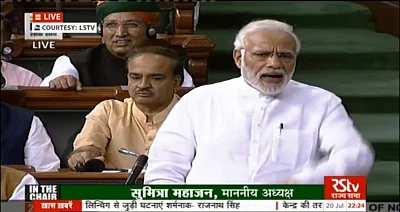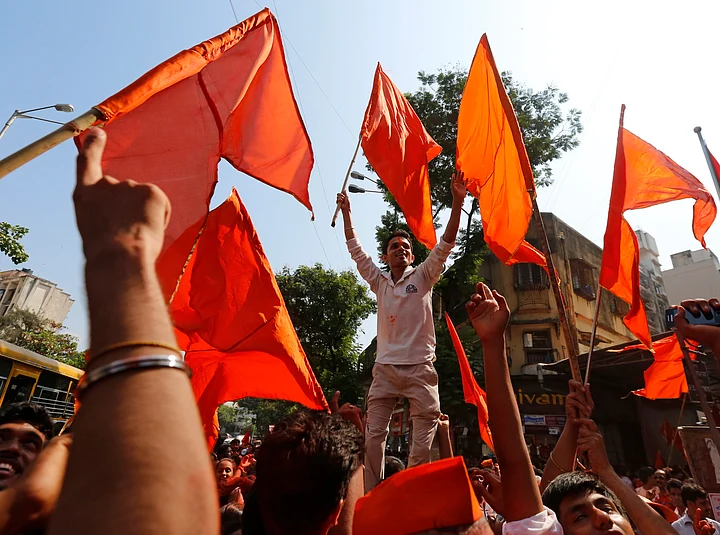The no confidence motion against the Modi government appears to have been hijacked by the sheer political theatre that unfolded in the Lok Sabha. Indeed, Rahul Gandhi’s hug-and-wink ambush of Prime Minister Narendra Modi at the start of the debate, and the latter’s withering counter-attack in the end have clearly grabbed the headlines. Yet, beyond the posturing by the two main protagonists of Friday’s soap opera in the hallowed precincts of the Indian Parliament, some hard realities of the current political scenario have emerged.
Despite the expected comfortable victory by the government in the no confidence vote, the BJP has reason to worry about the erosion within the larger ruling coalition NDA that had been elected to power in 2014.
Telugu Desam’s Confidence
The no confidence motion showed that the ruling party had lost the support of its two main, and by far largest, allies — the Telegu Dasam and the Shiv Sena. This cannot but bring back uncomfortable memories of the Vapayee led NDA losing key allies as it headed for defeat in the 2004 parliamentary polls.
The transformation of the Telegu Dasam, and its mercurial supremo Chandrababu Naidu, from a close friend to a bitter enemy will undoubtedly rankle with the Prime Minister.
As a matter of fact, Naidu had supported Modi even on controversial policy gambles like demonetization and the hasty and haphazard implementation of GST, and was, till recently, considered a trusted ally.
However, with the Telegu leader incensed at what he considers as the Centre’s betrayal over the promised financial special status for Andhra Pradesh, the pendulum has swung the other way. Not only did the Telegu Dasam take the lead in moving the no confidence motion but its members were the most vocal and offensive on the Opposition benches in their sloganeering even as the Prime Minister replied at the end of the debate.
Modi best actor in world: TDP MP

Shiv Sena’s Snub
Even more embarrassing for the BJP has been the snub by the Shiv Sena, which, in spite of being technically an NDA ally, pointedly abstained from the no confidence motion. This is also a personal rebuff to the powerful ruling party president Amit Shah, who had gone out of his way in recent weeks to placate his troublesome ally.
Too busy to read? Listen to it instead.
In fact, BJP spokespersons and publicists had earlier given the impression that Shah, after his meeting with the Sena Chief Uddhav Thackeray some weeks ago, had managed to defuse the running feud between the two parties. Even on the morning of the vote they were claiming that the Shiv Sena would be voting for the government.
The storm signals were apparent from a scathing editorial by the Sena mouthpiece, Samna, on the day of the vote. It pointedly stated that although the government had the numbers to win the no confidence motion, its purpose was to “whip the government publicly for its sins”.
The editorial went on to list the secret of the BJP’s electoral success as “immense money power, muscle power and manipulation of EVMs”.
According to Shiv Sena leader Sanjay Raut, frantic calls by Shah to Thackeray after the editorial appeared were ignored by the latter. To compound the rupture, the Sena members in Lok Sabha were one of the first to congratulate Rahul Gandhi for his provocative mockery of the Prime Minister.
BJP’s Damage Control
The BJP did manage, to some extent, counter the loss of support from its two main allies by neutralizing three parties who are not a part of the NDA. Its biggest success was to persuade the AIADMK, the largest Opposition party after the Congress, to actually vote in the government’s favour and managing to get the BJD in Orissa and TRS in Telengana to abstain. Had it not done so, the ruling party’s isolation in the Lok Sabha would have become far more apparent.
Unfortunately for the BJP, while providing it better optics in the result of the no confidence vote, the party may not find much strength or support from these three parties in the vote that really matters – the coming 2019 national polls.
Although support from a Jayalalitha-led AIADMK would have been a huge boost to the BJP, the party after her death is a pale shadow of its former self and is widely expected to be trounced in the next elections.
Without her charismatic leadership, the party is badly divided between warring factions and further sabotaged by the banished and incarcerated former Jayalalitha aide Sasikala and her political cohorts.
As for the BJD and the TRS, their abstention from the no confidence motion vote is unlikely to be replicated in an alliance or even understanding in the Lok Sabha polls. For instance, the BJD and its leader, chief minister Naveen Patnaik, simply cannot ally with the BJP which is their main political rival in Orissa. The BJD’s tactics in the Lok Sabha on Friday are, therefore, guided by getting short term benefits for the state at the moment from New Delhi rather than any political bonhomie with the BJP.
It is true that the BJP and the Prime Minister are close to the TRS and its leader Telengana chief minister Chandrasekhar Rao. Modi actually praised Rao in his no confidence motion speech.
The problem, however, is that with large pockets of Muslim population in Telengana particularly in the Hyderabad region, the TRS may find it difficult to have any kind of alliance with the BJP fearing a backlash in the minority vote.
Shorn of theatrics and the inconsequential result of the no confidence vote, the real political message that does come through with less than a year left for the 2019 parliamentary polls is that Prime Minister Modi and the BJP will have to do all the heavy lifting by themselves for the electoral battle ahead.
(The writer is a Delhi-based senior journalist. The views expressed above are the author’s own. The Quint neither endorses nor is responsible for the same)
(At The Quint, we question everything. Play an active role in shaping our journalism by becoming a member today.)


